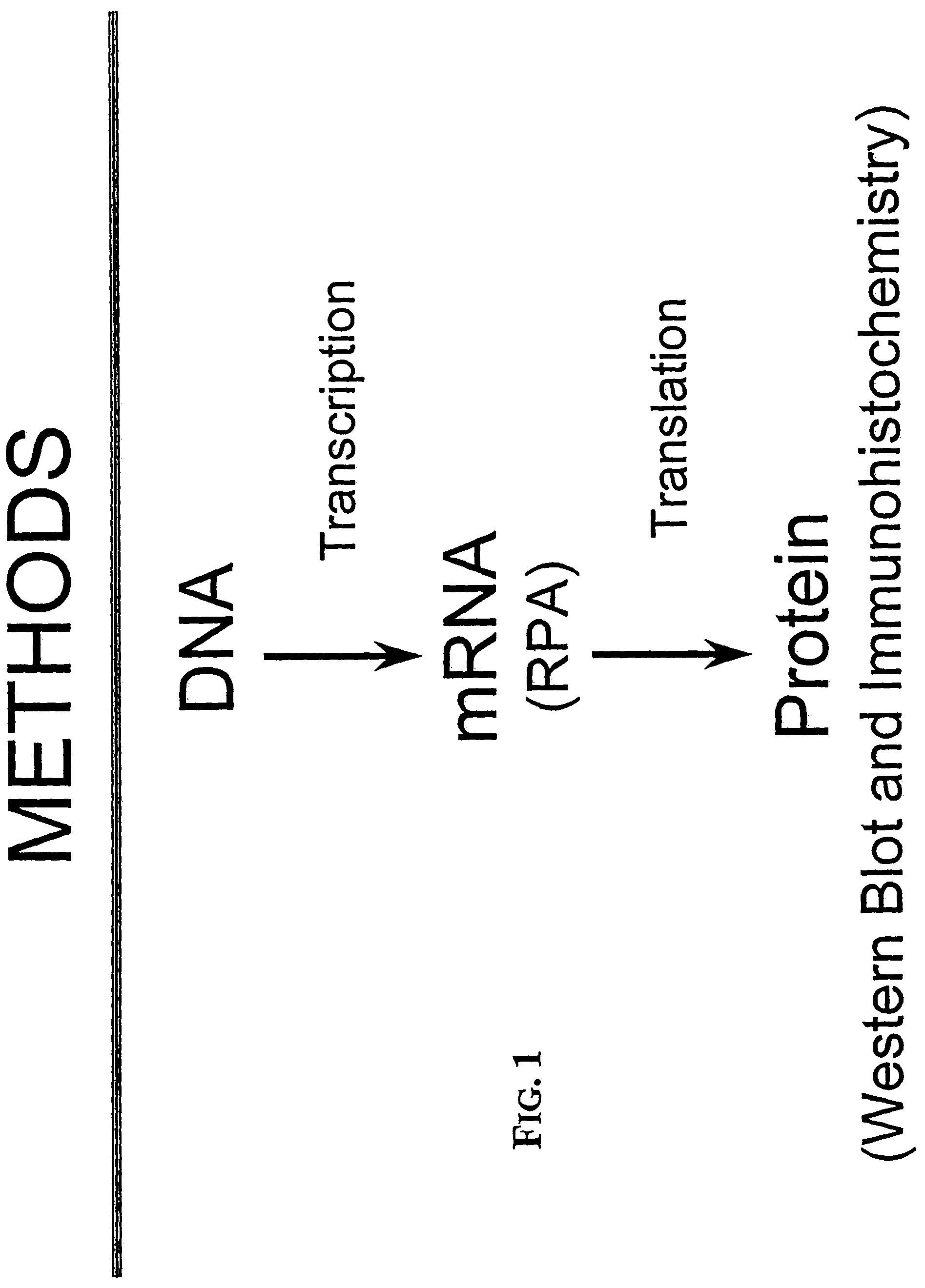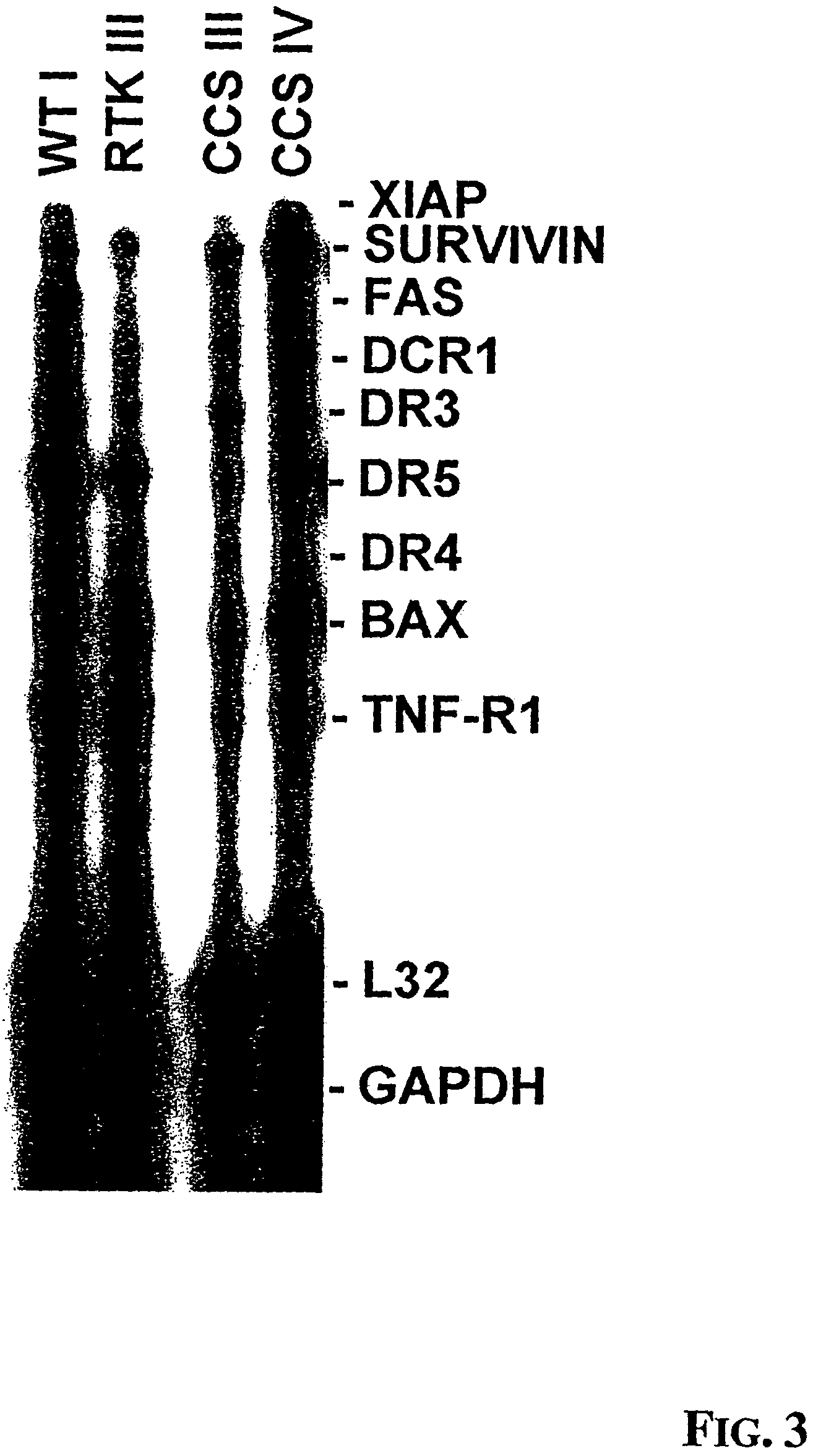Method for predicting tumor recurrence
a tumor recurrence and tumor technology, applied in the field of tumor recurrence prediction, can solve the problems of no recognized biologic markers, no available markers specific, treatment cannot be specifically guided nor can the prognosis be predicted
- Summary
- Abstract
- Description
- Claims
- Application Information
AI Technical Summary
Benefits of technology
Problems solved by technology
Method used
Image
Examples
example 1
The Survivin:Fas Ratio in Pediatric Renal Tumors
Materials and Methods
[0037]Tissue specimens: Thirty two frozen tissue specimens were obtained from pediatric patients with renal tumors prior to chemotherapy at the University of Iowa Hospitals and Clinics and from the National Wilms' Tumor Study group (NWTSG) tissue bank. Eleven normal kidney and 21 tumor specimens were assayed for expression of multiple mRNA species including Survivin and Fas. Normal kidney specimens were obtained from tissue adjacent to the resected tumors. The following pediatric renal tumors were assayed: Wilms' tumor (WT): Stage I (n=1), II (n=4), III (n=3), IV (n=1); Mesoblastic Nephroma (n=3); Clear cell sarcoma (CCS) stage II (n=2), III (n=1), IV (n=1); and Rhabdoid tumor of the kidney (RTK) stage II (n=2), III (n=1), IV (n=2). As a control, tissue from normal kidney (NK) was also tested (n=11).
[0038]RNase Protection Assay (RPA): The RiboQuant™ Multi-probe protection assay system (PharMingen, San Diego, Calif....
example 2
The Survivin:Fas Ratio as a Predictor of Neuroblastoma Recurrence
[0050]Neuroblastoma (NB) is a malignant tumor of childhood that arises from primordial neural crest cells. This tumor accounts for 8-10% of all childhood cancers and for 15% of cancer related deaths in children. (17) NB is distinct in its ability to spontaneously regress, but more frequently presents as a markedly aggressive tumor with a high risk for recurrence.
[0051]Several clinical and biologic features of NB are used to predict the risk of recurrent disease. Many of the biologic markers used, potentially reflect the tumor's ability to differentiate, proliferate, or undergo apoptosis (programmed cell death). It is feasible that the balance between anti-apoptotic factors and pro-apoptotic factors within a tumor cell could impact the cell's survival.
[0052]Survivin is detected in many tumors but is not present in normal differentiated adult tissue. Survivin is expressed during cell proliferation in the G2 / M phase of th...
example 3
The Survivin:BID and Survivin:p53 Ratio in Tumors
[0055]A predictive ratio can be determined by measuring other pro-apoptotic factors in addition to Fas. For example, a Survivin:BID and Survivin:p53 can be computed and used to predict tumor cell aggression (i.e., growth rate, sensitivity to drugs and activation induced cell death).
[0056]Two recently examined tissue specimens from two patients with Neuroblastoma of good prognosis revealed low Survivin levels and notably high Bid levels. Ratios were 0.2 and 0.17. Similarly, in these two patients Survivin:p53 ratios were 0.18 and 0.16. Survivin:Fas ratios were 0.6 and 0.7 respectively.
[0057]Similarly in an evaluation of several human NB cell lines it was seen that the more Survivin was suppressed (drug effect), which correlated with a decreased Survivin:Bid or Survivin:p53 ratio, the more sensitive the cell lines became to either spontaneous or activation induced cell death.
PUM
| Property | Measurement | Unit |
|---|---|---|
| Fraction | aaaaa | aaaaa |
| Fraction | aaaaa | aaaaa |
| Fraction | aaaaa | aaaaa |
Abstract
Description
Claims
Application Information
 Login to View More
Login to View More - R&D
- Intellectual Property
- Life Sciences
- Materials
- Tech Scout
- Unparalleled Data Quality
- Higher Quality Content
- 60% Fewer Hallucinations
Browse by: Latest US Patents, China's latest patents, Technical Efficacy Thesaurus, Application Domain, Technology Topic, Popular Technical Reports.
© 2025 PatSnap. All rights reserved.Legal|Privacy policy|Modern Slavery Act Transparency Statement|Sitemap|About US| Contact US: help@patsnap.com



